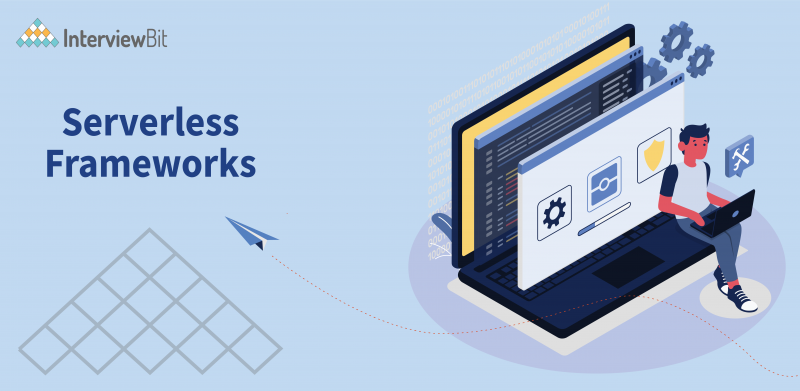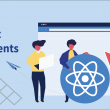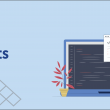Serverless does not actually mean without a server, what it actually means is really important to understand. You as a developer actually don’t care about the server behind the scenes. There is always a server working behind it because the code that a developer writes has to run somewhere.
The difference here is that if you are a developer then you don’t have to worry about writing code for the server, creating a server, maintaining a server, and deploying a server. All those things are taken away from you so you don’t have to worry about them.
As a developer, you have to focus upon writing the code, not on the infrastructure.
What is Serverless ?
Serverless is the path to create and deploy applications on the cloud. The developers do not have to worry about maintaining the cloud infrastructure. They only have to pay the amount on a per use basis.
Confused about your next job?
What is a Serverless Framework?
The serverless framework is a tool that helps you build service applications, which are apps that auto-scale massively while only charging you fractions of a cent, and now the framework comes with monitoring testing and security features to help you to operate those apps. All of which are available for free.
Top Serverless Frameworks
Now let’s understand the different types of serverless frameworks and the key features of them that are available to us.
1. Zappa
It is a very popular framework and it was really the frontrunners for a lot of these serverless frameworks and the inspiration for many others. It can be used for various purposes. It tends to be very popular for web-based applications or even REST API like solutions and one of the key strengths is to focus around solutions like python and if you have a WSGI( web server gateway interface) based apps like if you are using Flask, Deploy Django and you wanted to port that to serverless capability like AWS lambda and AWS API gateway, Zappa was the place to go.
Key observation:-
- It will provide a great abstraction for replatforming solutions which rely on things like Flask applications.
For example- if you have an existing Flask application and you use Zappa, It builds through the abstraction kind of allowing you to use AWS Lambda and API gateway without really having to change a lot of code - The deployment in Zappa is easy, you would not be so worried as it takes a single command to deploy ,update and control an application.
- Zappa provides the higher security it enables the identity and access management (IAM) strategy for authentication by default.
- Zappa uses DynamoDB as the backend to take the responses of asynchronous tasks.
2. Serverless
It is the most popular framework out there and one of the major facts that they tend to be platform neutral or cloud neutral in a manner of speaking, so it works with AWS, Google cloud as your Microsoft Azure and many others. So it is not a vendor lock-in or not very tied to AWS itself. Serverless is a general purpose serverless framework, so whether you are building web applications, REST API or IoT kind of applications using serverless technologies, it should allow you to walk seamlessly.
Key observation:-
- Serverless supports multiple languages like Node.js, Python, Java, Go, C#, Ruby, Swift, Kotlin, PHP, Scala.
- It is a command line tool that manages both code as well as cloud infrastructure that needs the large amount of serverless use-case.
- These are the existing frameworks and it is like a domain specific language (DSL) so it needs to get familiar with the frameworks configuration management tools
- It is full of automation as it has built-in support at different stages and optimizations. It also uploads the code to AWS Lambda by using functions and services very quickly.
3. AWS Chalice
Chalice is relatively new to the market. it tends to be very focused around delivering web and REST APIs. Now at this point it is really focusing on python and as we don’t have solutions for various other languages, so it is very centric to python. It tends to follow the conventions of popular micro-frameworks in python like Flask and it is very focused around specifying the URL routes.it mapping on to lambda and AWS gateway.
Key observation:-
- It provides command-line tools that create and manage the Flask applications in a structured way with the business logic.
- Like Zappa it enables the identity and access management (IAM) strategy for authentication by default.
- It helps to decorate the API integrating with Amazon API Gateway, Amazon S3, Amazon SNS, Amazon SQS, and other AWS services.
4.Claudia.js
Claudia.js is a very lightweight tool. It does a really good job of deploying managing and updating your API and serverless backend so it will deploy and manage the API Gateway service on AWS as well as lambda functions that connect to those API’s and it will handle setting them up so that the API triggers the lambda and the lambda can receive all of the data properly and then through the code you write in the lambda you can connect to all of these other AWS Services and perhaps the biggest thing is it allows you to code this infrastructure outside of the AWS console. Claudia is also great for plugging into
Infrastructure may be that you just created by clicking through the console, you can start a new Claudia project and just transfer management of that existing infrastructure.
Key observation:-
- Claudia provides the flexibility in AWS lambda and API gateway if you are able to set it up properly.
- You can deploy and update your applications by giving only one simple command.
- Claudia manages multiple versions simultaneously easily.
- Claudia helps Javascript developers to focus on finding the solutions for business problems instead of deploying the infrastructure.
5. Architect (AWS,Node)
This framework is a very advanced serverless framework that can be used to deploy, manage and maintain AWS cloud infrastructure with the attachment of node.js and NPM(node package manager).
Key observation:-
- The architect uses popular tools such as G Init conditions and Google Cloud Build to make deployment easy.
- Architect uses an app.arc file and compiles the code automatically configured and provisioned according to user permissions settings without doing any work manually.
- Architect helps Javascript developers to write, debug and test their business logics by simply running their codes.
6. Lambda Framework
The AWS Lambda is a compute service that runs your backend code in response to events such as objects uploaded to Amazon S3 buckets ,updates to Amazon DynamoDB tables data and Amazon kinesis dreams or in application activity. Once you upload your code to lambda the service handles all the capacity, scaling, patching and administration of the infrastructure to run your code and provides visibility into performance by publishing real-time metrics and logs to Amazon cloud watch. All you need to do is write the code.
Key observation:-
- Lambda is an open -source tool that provides easy deployment in serverless applications to API gateway.
- AWS lambda is very low cost and does not require any previous investment. You need to pay a fee per use.
- You can use any third party library, even native once in the AWS lambda framework.
- It provides various JAX-RS annotations and supports GET,POST,DELETE,HEAD ,PUT and other most common JSRs.
- Lambda functions support XML – based configuration with VPC (virtual private cloud)and custom execution roles.
7. Flogo( GO, AWS)
Flogo is a framework to create, deploy and manage applications easily on lambda using only Docker. Flogo supports a feathery, small-footprint design that helps to save time in the process of deployment and also helps to speedup your code live.
Key observation:-
- Flogo is an open source and customized framework that can easily deploy applications using Docker.
- It provides solutions for many organizations that need to take responses instantly, create apps in action to save time.
- Flogo supports the Golang programming language and visual web UI that can be used to design and create your apps.
- Flogo supports flexibility like you only need to pay per request to use. You don’t need to overpay for the time when your app is not active.
8. Jets
If you have command of the Ruby language and you want to create and deploy your applications in this featured language, then you can definitely go for jets. As you know, many server-side web applications frameworks are written in ruby language so Jets is one of them that also supports various tools. They help developers to create and deploy applications using AWS LAMBDA, SNS (Social Networking Service), SQS (Amazon Simple Queue Service), DynamoDB, and other services.
Key observation:-
- Jets can also have its own functions that can be used to comprise different resources provided by AWS.
- It works in such a way that the code can directly convert into lambda functions and AWS resources to save time.
9. Deep Framework
Deep stands for Digital Enterprise End- to-end Platform. It is a Full-Stack Framework for creating cloud-supportive web applications. Deep frameworks provide AWS services; it also includes Google Cloud Platform, Microsoft Azure, and API gateways. It abstracted the access to use the web services from cloud providers like AWS, GCP etc.
Key observation:-
- Deep-Framework is a scalable multi-stream framework that is based on Docker and abstracts away from the user the complexity.
- It is an open source tool with 531 stars and 71 forks on GitHub.
- Deep uses AWS Lambda, API Gateway, DynamoDB to create and deploy the applications.
- It also supports security. To control who is authenticated (signed in) and authorized (has permissions) , a deep framework provides AWS IAM (Identity and Access Management ) to use resources.
10. Sigma
The sigma platform creates, monitors, and debug solutions and codes in real-time by offering a cloud-based environment to support serverless development ideas. It is a fully- featured IDE that manages the solutions directly in your browser. It provides serverless projects in AWS and GCP(Azure coming soon).
Key observation:-
- It completely depends on the browser and does not require a backend service to operate.
- The deployment of the applications is incremental and it integrates with AWS Lambda, AWS API , DynamoDB and many other AWS Services.
- The sigma IDE highly supports NodeJS as it supports real time applications.
Conclusion
There are different amazing serverless frameworks nowadays. The Serverless Framework provides a simple and effective abstraction of the AWS Lambda package and deploy process that will help you to start up a project.
This technology saves us not only money but more resources by sizing resources in accordance with traffic demand, and also it also gives us the chance to publish applications to the market with less time and improve value by optimizing your application.
Serverless computing is the new trend of developing and deploying our applications on the cloud. In the upcoming years there will be many more new serverless frameworks developed to ease the solutions of the companies as well as cost optimizations and also to provide some more advantages to the technologies.
Finally, a secure application will protect your organization’s sensitive information assets and meet any compliance requirements at every layer by using some AWS services like identity and access management (IAM).
FAQ
Q: The Need for Serverless Framework
A: As we all know that the technologies are increasing in the exponential order, so developers have to use their energy to deploy and to create the best service apps not to manage the infrastructure. So to simplify the deployment of the infrastructure and its usage we need a tool named as serverless framework. All infrastructure like stuff is abstracted from the developers and handled by some managed service.
Q: Are Serverless Frameworks Free?
A: Serverless frameworks are charged on a per use basis. As services are computed and managed the changes are based on that. An organization can have complete resource utilization without paying a cent for idle time. It never pays for resources you don’t use.it provides 90% cost-savings over a cloud infrastructure.
Q: Are Serverless Frameworks Popular?
A: Serverless computing is the new trend of developing and deploying applications on the cloud. They are going to be very popular day by day. The use of serverless frameworks is increasing in an exponential order because all the companies and developers are trying to do their work easily; they can complete the task in a very less amount of time by using serverless frameworks. It provides the deployment of infrastructure and helps to build different applications with serverless architecture by using amazon web services(AWS). The developers do not worry about the deployment of the infrastructure. It is handled by the various backend services.
Q: Who is Using Serverless Frameworks?
A: There are many organizations that are using serverless frameworks as it is a very simple way to deploy the AWS Lambda applications. So here is the list of the companies that are using serverless frameworks nowadays.
- Netflix
- Codepen
- Zalora
- Coca-Cola
- NordStrom




